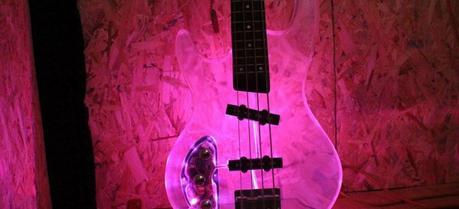 Picture of a guitar made of methyl methacrylate (PMMA), a transparent thermoplastic, often used as a lightweight or shatter-resistant alternative to glass. (Credit: Irritater http://en.wikipedia.org/wiki/File:Basscat_Bass.jpg)
Picture of a guitar made of methyl methacrylate (PMMA), a transparent thermoplastic, often used as a lightweight or shatter-resistant alternative to glass. (Credit: Irritater http://en.wikipedia.org/wiki/File:Basscat_Bass.jpg)
Evonik Industries, a German maker of speciality chemicals, has for the first time used biotechnology to convert synthesis gas (syngas) into a chemical compound that can be used to manufacture Plexiglas—a transparent thermoplastic, often used as a lightweight or shatter-resistant alternative to glass. Waste gas is one example of a source of syngas.
“We have shown that there is a safe way of using bacteria to turn syngas into a variety of products in the future,” says Dr. Peter Nagler, Evonik’s Chief Innovation Officer. In addition to 2-hydroxyisobutyric acid (2-HIBA) that was produced in this experiment, chemists can produce other products like C4 alcohols for the paints and varnishes industry.
Syngas, or synthesis gas, is a fuel gas mixture consisting primarily of hydrogen, carbon monoxide, and very often some carbon dioxide. These gases can be generated from municipal or agricultural waste, or from the waste gases produced in industries such as steel production.
For its purposes, Evonik used the bacteria that lived on Earth at a time when oxygen was not yet present in the atmosphere. These microorganisms today still carry the genetic information needed to convert carbon monoxide, carbon dioxide, and hydrogen into more valuable molecules. Evonik has used their enzymes to create a cell factory that generates specialty chemicals from syngas.
“We have a long way to go before we can use bacteria for converting syngas to high-quality specialty chemicals on a large industrial scale,” says Dr. Thomas Haas, head of Biotechnology at Creavis, Evonik’s strategic innovation unit. “It will still take a couple of years until it is ready for the market.”
“In addition to sugar or residual plant materials converted to syngas, waste from other sources such as municipal waste and industrial waste gas can also serve as raw materials. That makes us less dependent not only on fossil-based raw materials, but also on renewable resources that could potentially compete with the food supply,” explained Haas.
2-HIBA can also be produced via chemical synthesis. Both the chemically-produced and biotech-produced products can be converted to methyl methacrylate (MMA). MMA is used in paints, varnishes, and anti-rust coatings, as well as in soft contact lenses and dental implants.

